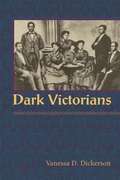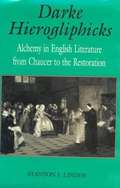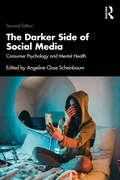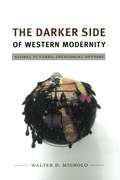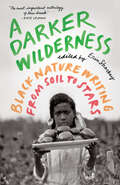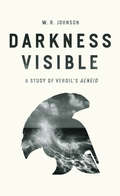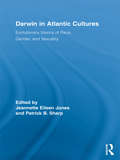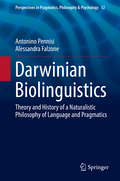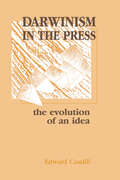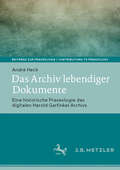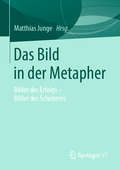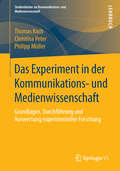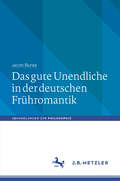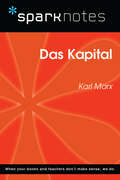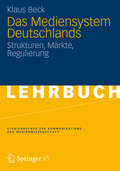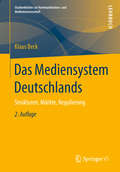- Table View
- List View
Dark Victorians
by Vanessa D. DickersonDark Victorians illuminates the cross-cultural influences between white Britons and black Americans during the Victorian age. In carefully analyzing literature and travel narratives by Ida B. Wells, Harriet Martineau, Charles Dickens, Frederick Douglass, Thomas Carlyle, W.E.B. Du Bois, and others, Vanessa D. Dickerson reveals the profound political, racial, and rhetorical exchanges between the groups. From the nineteenth-century black nationalist David Walker, who urged emigrating African Americans to turn to England, to the twentieth-century writer Maya Angelou, who recalls how those she knew in her childhood aspired to Victorian ideas of conduct, black Americans have consistently embraced Victorian England. At a time when scholars of black studies are exploring the relations between diasporic blacks, and postcolonialists are taking imperialism to task, Dickerson considers how Britons negotiated their support of African Americans with the controlling policies they used to govern a growing empire of often dark-skinned peoples, and how philanthropic and abolitionist Victorian discourses influenced black identity, prejudice, and racism in America.
Darke Hierogliphicks: Alchemy in English Literature from Chaucer to the Restoration
by Stanton J. LindenThe literary influence of alchemy and hermeticism in the work of most medieval and early modern authors has been overlooked. Stanton provides the first comprehensive examination of this influence on English literature from the late middle Ages.
The Darker Side of Social Media: Consumer Psychology and Mental Health
by Angeline Close ScheinbaumThe Darker Side of Social Media: Consumer Psychology and Mental Health takes a research-based, scientific approach to examining problematic issues and outcomes that are related to social media use by consumers. Now in its second edition, it relies on psychological theories to help explain or predict problematic online behavior within the social media landscape through the lens of mental health.With an aim to provide solutions, the authors spotlight the key issues affecting consumer well-being and mental health due to the omnipresence and overuse of social media. The book dissects the unintended consequences of too much social media use, specifying key problems like disconnection anxiety, eating disorders, online fraud, cyberbullying, the dark web, addiction, depression, self-discrepancies, and serious privacy concerns (especially impacting children or young people). The book provides grapples with mental health disorders such as anxiety, depression, self-harm, and eating disorders that can be intensified by, or correlated with, too much social media use. The authors meticulously review the various facets of the darker side of online presence and propose actionable solutions for each of the problems stated, providing scholars with a conceptual model with propositions for continued research.This international exploration of social media is a must-read for students of marketing, advertising, and public relations, as well as scholars/managers of business, marketing, psychology, communication, management, and sociology. It will also be of interest to social media users, those navigating new media platforms parents, policymakers, and practitioners.
The Darker Side of Western Modernity: Global Futures, Decolonial Options
by Walter D. MignoloDuring the Renaissance and the Enlightenment, coloniality emerged as a new structure of power as Europeans colonized the Americas and built on the ideas of Western civilization and modernity as the endpoints of historical time and Europe as the center of the world. Walter D. Mignolo argues that coloniality is the darker side of Western modernity, a complex matrix of power that has been created and controlled by Western men and institutions from the Renaissance, when it was driven by Christian theology, through the late twentieth century and the dictates of neoliberalism. This cycle of coloniality is coming to an end. Two main forces are challenging Western leadership in the early twenty-first century. One of these, "dewesternization," is an irreversible shift to the East in struggles over knowledge, economics, and politics. The second force is "decoloniality." Mignolo explains that decoloniality requires delinking from the colonial matrix of power underlying Western modernity to imagine and build global futures in which human beings and the natural world are no longer exploited in the relentless quest for wealth accumulation.
A Darker Wilderness: Black Nature Writing From Soil to Stars
by Erin SharkeyA vibrant collection of personal and lyric essays in conversation with archival objects of Black history and memory. <P><P> What are the politics of nature? Who owns it, where is it, what role does it play in our lives? Does it need to be tamed? Are we ourselves natural? In A Darker Wilderness, a constellation of luminary writers reflect on the significance of nature in their lived experience and on the role of nature in the lives of Black folks in the United States. Each of these essays engages with a single archival object, whether directly or obliquely, exploring stories spanning hundreds of years and thousands of miles, traveling from roots to space and finding rich Blackness everywhere. <P><P> Erin Sharkey considers Benjamin Banneker’s 1795 almanac, as she follows the passing of seasons in an urban garden in Buffalo. Naima Penniman reflects on a statue of Haitian revolutionary François Makandal, within her own pursuit of environmental justice. Ama Codjoe meditates on rain, hair, protest, and freedom via a photo of a young woman during a civil rights demonstration in Alabama. And so on—with wide-ranging contributions from Carolyn Finney, Ronald Greer II, Alexis Pauline Gumbs, Sean Hill, Michael Kleber-Diggs, Glynn Pogue, Katie Robinson, and Lauret Savoy—unearthing evidence of the ways Black people’s relationship to the natural world has persevered through colonialism, slavery, state-sponsored violence, and structurally racist policies like Jim Crow and redlining. <P><P> A scrapbook, a family chest, a quilt—and an astounding work of historical engagement and literary accomplishment—A Darker Wilderness is a collection brimming with abundance and insight.
Darkness Moves
by Henri MichauxHenri Michaux defies common critical definition. Critics have compared his work to such diverse artists as Kafka, Goya, Swift, Klee, and Beckett. Allen Ginsberg called Michaux "genius," and Jorge Luis Borges wrote that Michaux's work "is without equal in the literature of our time." This anthology contains substantial selections from almost all of Michaux's major works, most never before published in English, and allows readers to explore the haunting verbal and pictorial landscape of a twentieth-century visionary.
Darkness Visible: A Study of Vergil's "Aeneid"
by W.R. JohnsonOne of the best books ever written on one of humanity’s greatest epics, W. R. Johnson’s classic study of Vergil’s Aeneid challenges centuries of received wisdom. Johnson rejects the political and historical reading of the epic as a record of the glorious prehistory of Rome and instead foregrounds Vergil’s enigmatic style and questioning of the heroic myths. With an approach to the text that is both grounded in scholarship and intensely personal, and in a style both rhetorically elegant and passionate, Johnson offers readings of specific passages that are nuanced and suggestive as he focuses on the “somber and nourishing fictions” in Vergil’s poem. A timeless work of scholarship, Darkness Visible will enthrall classicists as well as students and scholars of the history of criticism—specifically the way in which politics influence modern readings of the classics—and of poetry and literature.
Darwin in Atlantic Cultures: Evolutionary Visions of Race, Gender, and Sexuality
by Jeannette Eileen Jones Patrick B. SharpThis collection is an interdisciplinary edited volume that examines the circulation of Darwinian ideas in the Atlantic space as they impacted systems of Western thought and culture. Specifically, the book explores the influence of the principle tenets of Darwinism -- such as the theory of evolution, the ape-man theory of human origins, and the principle of sexual selection -- on established transatlantic intellectual traditions and cultural practices. In doing so, it pays particular attention to how Darwinism reconfigured discourses on race, gender, and sexuality in a transnational context. Covering the period from the publication of The Origin of Species (1859) to 1933, when the Nazis (National Socialist Party) took power in Germany, the essays demonstrate the dissemination of Darwinian thought in the Western world in an unprecedented commerce of ideas not seen since the Protestant Reformation. Learned societies, literary groups, lyceums, and churches among other sites for public discourse sponsored lectures on the implications of Darwin’s theory of evolution for understanding the very ontological codes by which individuals ordered and made sense of their lives. Collectively, these gatherings reflected and constituted what the contributing scholars to this volume view as the discursive power of the cultural politics of Darwinism.
Darwin Loves You: Natural Selection and the Re-enchantment of the World
by George LevineJesus and Darwin do battle on car bumpers across America. Medallions of fish symbolizing Jesus are answered by ones of amphibians stamped "Darwin," and stickers proclaiming "Jesus Loves You" are countered by "Darwin Loves You." The bumper sticker debate might be trivial and the pronouncement that "Darwin Loves You" may seem merely ironic, but George Levine insists that the message contains an unintended truth. In fact, he argues, we can read it straight. Darwin, Levine shows, saw a world from which his theory had banished transcendence as still lovable and enchanted, and we can see it like that too--if we look at his writings and life in a new way. Although Darwin could find sublimity even in ants or worms, the word "Darwinian" has largely been taken to signify a disenchanted world driven by chance and heartless competition. Countering the pervasive view that the facts of Darwin's world must lead to a disenchanting vision of it, Levine shows that Darwin's ideas and the language of his books offer an alternative form of enchantment, a world rich with meaning and value, and more wonderful and beautiful than ever before. Without minimizing or sentimentalizing the harsh qualities of life governed by natural selection, and without deifying Darwin, Levine makes a moving case for an enchanted secularism--a commitment to the value of the natural world and the human striving to understand it.
Darwinian Biolinguistics: Theory and History of a Naturalistic Philosophy of Language and Pragmatics (Perspectives in Pragmatics, Philosophy & Psychology #12)
by Antonino Pennisi Alessandra FalzoneThis book proposes a radically evolutionary approach to biolinguistics that consists in considering human language as a form of species-specific intelligence entirely embodied in the corporeal structures of Homo sapiens. The book starts with a historical reconstruction of two opposing biolinguistic models: the Chomskian Biolinguistic Model (CBM) and the Darwinian Biolinguistic Model (DBM). The second part compares the two models and develops into a complete reconsideration of the traditional biolinguistic issues in an evolutionary perspective, highlighting their potential influence on the paradigm of biologically oriented cognitive science. The third part formulates the philosophical, evolutionary and experimental basis of an extended theory of linguistic performativity within a naturalistic perspective of pragmatics of verbal language. The book proposes a model in which the continuity between human and non-human primates is linked to the gradual development of the articulatory and neurocerebral structures, and to a kind of prelinguistic pragmatics which characterizes the common nature of social learning. In contrast, grammatical, semantic and pragmatic skills that mark the learning of historical-natural languages are seen as a rapid acceleration of cultural evolution. The book makes clear that this acceleration will not necessarily favour the long-term adaptations for Homo sapiens.
Darwinism in the Press: the Evolution of An Idea (Routledge Communication Series)
by Edward CaudillNumerous books and articles have outlined Darwin's impact on American scientists, philosophers, businessmen, and clergy in the 19th and early 20th centuries. Few, however, have undertaken a study of Darwinism in the form in which it was presented to most Americans -- popular newspapers and magazines. The main concern of this book is to identify how the press is treated as a part of our culture - - pointing to its ability to shape and to be shaped by the forces that act on the rest of society and its ability to be critical in the interpretation of ideas for "the masses."
Darwin's Plots
by Gillian BeerGillian Beer's classic Darwin's Plots, one of the most influential works of literary criticism and cultural history of the last quarter century, is here reissued in an updated edition to coincide with the anniversary of Darwin's birth and of the publication of The Origin of Species. Its focus on how writers, including George Eliot, Charles Kingsley and Thomas Hardy, responded to Darwin, Aos discoveries and to his innovations in scientific language continues to open up new approaches to Darwin's thought and to its effects in the culture of his contemporaries. This third edition includes an important new essay that investigates Darwin's concern with consciousness across all forms of organic life. It demonstrates how this fascination persisted throughout his career and affected his methods and discoveries. With an updated bibliography reflecting recent work in the field, this book will retain its place at the heart of Victorian studies
Das Archiv lebendiger Dokumente: Eine historische Praxeologie des digitalen Harold Garfinkel Archivs (Beiträge zur Praxeologie / Contributions to Praxeology)
by André HeckAls „Vater&“ der Ethnomethodologie war Harold Garfinkels übergreifendes Anliegen „the study of the everyday practices used by the ordinary members of society in order to deal with their day-to-day lives&”. Seine Herangehensweise und die Konzipierung der Ethnomethodologie entspringen fundamental einer Kritik an Auguste Comtes Individualismus, welche zuerst von Émile Durkheim vorgetragen und von Talcott Parsons weiterentwickelt wurde, welcher schließlich Garfinkels Dissertation an der Universität Harvard betreute. In den folgenden sieben Jahrzehnten wurde die Ethnomethodologie zu einer ebenso einflussreichen wie kontrovers diskutierten Strömung, nicht nur innerhalb der Soziologie, sondern in einer Vielzahl von Wissenschaftszweigen. Die vorliegende Arbeit zeigt, wie der Aufbau eines virtuellen Archivs basierend auf der Sammlung von Unterlagen aus Harold Garfinkels persönlichem Büro einen Beitrag zur Entwicklung einer „Sociological Theory of Information&“ in seinem Sinne leistet.
Das Bild in der Metapher: Bilder des Erfolgs – Bilder des Scheiterns
by Matthias JungeBilder und bildliche Vorstellungen bestimmen von der frühesten Kommunikation an unseren Zugang zur Welt. Das Ziel des Bandes ist eine umfassende Aufklärung der Prägung unserer Welt durch die verwendeten Bilder entlang ausgewählter Beispiele alltäglicher Bildlichkeit.
Das Bilderbuch: Theoretische Grundlagen und analytische Zugänge
by Ben Dammers Anne Krichel Michael StaigerDas Bilderbuch ist ein vielschichtiges multimodales Erzählmedium, das in den vergangenen Jahrzehnten einen tiefgreifenden ästhetischen Wandel durchlaufen hat. Dieser Band bietet eine umfassende Grundlage für die Arbeit in Lehrveranstaltungen: Im ersten Teil wird in die Theorie und Geschichte des Bilderbuchs eingeführt und ein sechsdimensionales Analysemodell vorgestellt. Der zweite Teil enthält fünfzehn Modellanalysen mit jeweils unterschiedlichen Fokussierungen, z.B. zu Aspekten der bildlichen und sprachlichen Gestaltung im Bilderbuch oder zu ausgewählten Gattungen und Themen. – Mit Leitfragen zur Analyse und vielen farbigen Abbildungen.
Das Experiment in der Kommunikations- und Medienwissenschaft: Grundlagen, Durchführung und Auswertung experimenteller Forschung (Studienbücher zur Kommunikations- und Medienwissenschaft)
by Thomas Koch Christina Peter Philipp MüllerDas Lehrbuch bietet einen umfassenden Überblick über das sozialwissenschaftliche Experiment. Es stellt Grundlagen und zentrale Begriffe vor und dient als praktischer Leitfaden, um Experimente durchzuführen. Mit zahlreichen Beispielen aus der Kommunikationswissenschaft liefert dieses Buch eine umfassende Hilfestellung für Methodenkurse und empirische Forschungsprojekte, die sich der experimentellen Forschung widmen.
Das Formular (AdminiStudies. Formen und Medien der Verwaltung #1)
by Peter Plener Niels Werber Burkhardt WolfWenn stimmt, was bereits Friedrich Schiller beklagt hat: dass der Mensch in der modernen Gesellschaft „zum Formular geworden“ ist, dann steht mit diesem unscheinbaren Verwaltungs-tool nichts weniger als unsere Lebenswirklichkeit auf dem Spiel. Der erste (Open Access-)Band der Reihe AdminiStudies beschäftigt sich deshalb mit der Funktion und Geschichte von Formularen, jenen institutionalisierten Lückentexten, die den Alltag der Bürger dadurch entscheidend prägen, dass sie die Befehlsgewalt des Staats und seinen Willen zum Wissen auf zwingende Weise verschränken. Von Blanketten und handgeschriebenen Formularbüchern über Vordrucke zur militärischen und steuerlichen Erfassung bis hin zu den Telegramm-Vorlagen des 19. Jahrhunderts und zu den digitalen Schreibfeldern heutiger Ämter und Social Media reicht die Macht- und Mediengeschichte des Formulars. Die Grenze zwischen Untertanen, Bürgern und Kunden ist durchlässig geworden, und an den Affordanzen digitaler Formulare lassen sich die gegenwärtigen Bauformen administrativer Herrschaft ablesen.
Das ganze Leben – Repräsentationen von Arbeit in Texten über Kindheit und Jugend (Studien zu Kinder- und Jugendliteratur und -medien #12)
by Caroline Roeder Christine LötscherArbeit bedeutet im 21. Jahrhundert nicht (mehr) das sprichwörtliche ›halbe Leben‹, sondern erstreckt sich heute in zunehmender Entgrenzung auf alle Lebensbereiche. Der vorliegende Band umfasst 20 Beiträge und stellt die Untersuchung von Repräsentationen von Arbeit in Kindheit und Jugend erzählenden Texten sowie im Textkorpus der Kinder- und Jugendliteratur in den Mittelpunkt. Die historisch wie kulturwissenschaftlich ausgerichteten Ansätze eröffnen neue Blickwinkel; mediale wie populärkulturelle Fragestellungen erweisen sich als zentrale, weiterführende Arbeitsfelder.
Das gute Unendliche in der deutschen Frühromantik (Abhandlungen zur Philosophie)
by Jacob BurdaDas Buch eröffnet einen völlig anderen Blick auf die Romantik: Anstelle von Nostalgie, unendlicher und unerfüllter Annäherung steht das Harmonische und Versöhnliche im Mittelpunkt. Jacob Burda vertritt die in der Forschungsliteratur neue These, dass die Figur der guten Unendlichkeit schon der Frühromantik zuzuordnen ist - und nicht erst mit G.W.F. Hegel beginnt. Das hat weitreichende Konsequenzen für die Ästhetik, die Theologie und das Kunstverständnis, das wir gemeinhin mit der Romantik assoziieren. – Mit einem Geleitwort von Bazon Brock und einer Replik von Manfred Frank.
Das Kapital (SparkNotes Philosophy Guide)
by SparkNotesDas Kapital (SparkNotes Philosophy Guide) Making the reading experience fun! SparkNotes Philosophy Guides are one-stop guides to the great works of philosophy–masterpieces that stand at the foundations of Western thought. Inside each Philosophy Guide you&’ll find insightful overviews of great philosophical works of the Western world.
Das Mediensystem Deutschlands: Strukturen, Märkte, Regulierung (Studienbücher zur Kommunikations- und Medienwissenschaft)
by Klaus BeckDiese Einführung bietet eine historisch fundierte (ab 1945) systematische Darstellung der Grundstrukturen des bundesdeutschen Mediensystems und seiner kommunikationspolitischen Genese, insbesondere der ökonomischen, rechtlichen und technischen Grundlagen und Funktionsweisen der Medien der öffentlichen Kommunikation Printmedien, Rundfunk, Film, Online-Medien) sowie der medien-übergreifenden Strukturen/ Rahmenbedingungen (Nachrichten-, PR- und Werbeagenturen) sowie TK-Dienstleister. Darüber hinaus werden komparatistische Bezüge zu den Mediensystemen Österreichs und der Schweiz sowie Basisinformationen zu diesen beiden Mediensystemen hergestellt.
Das Mediensystem Deutschlands: Strukturen, Märkte, Regulierung (Studienbücher Zur Kommunikations- Und Medienwissenschaft Ser.)
by Klaus BeckDiese Einführung bietet eine historisch fundierte (ab 1945) systematische Darstellung der Grundstrukturen des bundesdeutschen Mediensystems und seiner kommunikationspolitischen Genese, insbesondere der ökonomischen, rechtlichen und technischen Grundlagen und Funktionsweisen der Medien der öffentlichen Kommunikation Printmedien, Rundfunk, Film, Online-Medien) sowie der medien-übergreifenden Strukturen/ Rahmenbedingungen (Nachrichten-, PR- und Werbeagenturen) sowie TK-Dienstleister. Darüber hinaus werden komparatistische Bezüge zu den Mediensystemen Österreichs und der Schweiz sowie Basisinformationen zu diesen beiden Mediensystemen hergestellt.
Das Nachrichtenverständnis junger Menschen: Definitionen und Erwartungen im Kontext aktueller journalistischer Information
by Markus WolsifferObwohl relativ viel über ihre Mediennutzung bekannt ist, weiß die Forschung erstaunlich wenig darüber, welche Erwartungen junge Menschen an journalistische Nachrichten richten. Ihre Perspektive wurde in Wissenschaft und Praxis lange vernachlässigt. Markus Wolsiffer setzt sich in diesem Band mit diesen Fragen auseinander und legt dar, weshalb die Erforschung des Nachrichtenverständnisses für eine Gesellschaft wichtig ist. Digitalisierung, wachsende Angebotsdifferenzierung und veränderte Nutzungsweisen führen zu Verwerfungen in der Medienwelt. Mittlerweile haben viele traditionelle Medienhäuser große Probleme, junge Menschen überhaupt noch zu erreichen. Jenseits ökonomischer Kalküle stellen sich damit auch normativ-demokratietheoretische Fragen: Was passiert mit einer Gesellschaft, wenn Nachrichten an Bedeutung verlieren und nichtjournalistische Plattformen zur bevorzugten Informationsquelle werden? Mit einer Kombination aus quantitativer und qualitativer Forschung liefert Markus Wolsiffer wichtige empirisch-analytische Grundlagen. Zugleich vermitteln seine Ergebnisse auch praktische Hinweise für Medienmacher und die Branche insgesamt.
Das persönliche Gespräch: Großspender und Unternehmer erfolgreich ansprechen
by Andreas SchiemenzGroßspenden und Unternehmensspenden stellen einen der wichtigsten Erfolgsfaktoren im Fundraising dar und erfordern bei der Akquise besondere Herangehensweisen. Nur mit einer gezielten und persönlichen Ansprache lassen sich Großspender und Unternehmer als Unterstützer gewinnen. Schritt für Schritt erläutert Andreas Schiemenz - selbst mit langjähriger Erfahrung im Bereich des Fundraising für Großspender und Unternehmen in verschiedenen Non-Profit-Organisationen - wie Sie die richtigen Ansprechpartner finden und auswählen, eine individuelle Kommunikationsstrategie entwickeln, Gespräche mit potenziellen Spendern effizient nachbereiten und wie Sie Geber zu langfristigen Spendern machen. Dabei werden sowohl die strukturellen Prozesse bei der Tätigkeit von Spendenorganisationen beleuchtet als auch die praktische Umsetzung anhand zahlreicher Praxisbeispiele vorgestellt. ,,Fundraising macht Menschen glücklich" - die Geber, die Spendensammler und die Menschen, denen mit den finanzierten Projekten geholfen werden kann.
Das persönliche Gespräch: Großspender und Unternehmer erfolgreich ansprechen
by Andreas SchiemenzGroßspenden und Unternehmensspenden stellen einen der wichtigsten Erfolgsfaktoren im Fundraising dar und erfordern bei der Akquise besondere Herangehensweisen. Nur mit einer gezielten und persönlichen Ansprache lassen sich Großspender und Unternehmer als Unterstützer gewinnen. Schritt für Schritt erläutert Andreas Schiemenz – selbst mit langjähriger Erfahrung im Bereich des Fundraising für Großspender und Unternehmen in verschiedenen Non-Profit-Organisationen – wie Sie die richtigen Ansprechpartner finden und auswählen, eine individuelle Kommunikationsstrategie entwickeln, Gespräche mit potenziellen Spendern effizient nachbereiten und wie Sie Geber zu langfristigen Spendern machen. Dabei werden sowohl die strukturellen Prozesse bei der Tätigkeit von Spendenorganisationen beleuchtet als auch die praktische Umsetzung anhand zahlreicher Praxisbeispiele vorgestellt. „Fundraising macht Menschen glücklich“ – die Geber, die Spendensammler und die Menschen, denen mit den finanzierten Projekten geholfen werden kann.Die zweite Auflage wurde aktualisiert, um neue Gesprächsbeispiele und ein weiteres Kapitel ergänzt.
